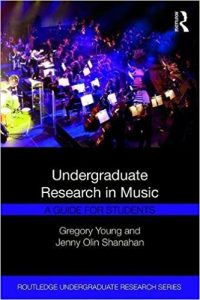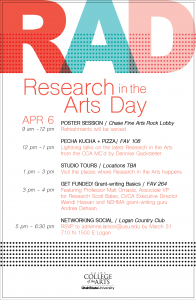“The School of Music’s participation in the 2017 Sousa Festival placed MSU into conversation with some of our country’s best musical ensembles,” said Royce Smith, dean of the MSU College of Arts and Architecture. “Our students and faculty also showcased a quintessentially Montana program, playing a beautiful Sousa march alongside a world-premiere piece composed by MSU music professor Greg Young, which featured the sounds of bugling elk. The new work was arranged by music education major Joseph Dresen, who did this as his senior undergraduate research project. With (MSU’s) President, Waded Cruzado, representatives of the Cuban Embassy in Washington and several university delegates in attendance, MSU took the Kennedy Center by storm and showed what a world-class program we have in music and the arts here in Bozeman.”
Creative Inquiry in the Arts and Humanities Institute (by CUR)
The Institute will assist teams of 3-5 faculty and administrators to develop transformative opportunities for Undergraduate Research, Scholarship, and Creativity (URSC) in the arts and humanities.
Next Offering: November 10-12, 2017 – The Lincoln University, PA
Application deadline: September 25, 2017. Accepted teams will be notified by September 29, 2017.
http://www.cur.org/conferences_and_events/institutes/creative_inquiry_institute/
First round of NEH Humanities Connections Grants Awarded
Eighteen institutions were awarded up to $100,000 to fund interdisciplinary instructional modules under this innovative grant program. CURAH advocacy played a role in its creation!
https://www.neh.gov/news/press-release/2017-04-03
Montana State University Undergraduate Researcher in Music presents at World Congress on Undergraduate Research
 Greg Young, professor of music, veteran CURAH councilor, and author with Jenny Shanahan of the forthcoming Undergraduate Research in Music , sends this link: http://www.montana.edu/news/16320/recent-msu-graduate-to-present-at-world-congress-on-undergraduate-research-in-qatar
Greg Young, professor of music, veteran CURAH councilor, and author with Jenny Shanahan of the forthcoming Undergraduate Research in Music , sends this link: http://www.montana.edu/news/16320/recent-msu-graduate-to-present-at-world-congress-on-undergraduate-research-in-qatar
RAD! Research in the Arts Day at Utah State University
 This year the Caine College of the Arts at Utah State University celebrated its second art-focused research festival. Events included a poster and presentation session, a workshop on grant-writing in the arts, a networking party, and (crowd favorite) a Pecha Kucha style event, which is a fun, energetic session in which presenters have six minutes and forty seconds to speak in front of twenty slides that rotate on a twenty-second basis — it’s a combo of performance art, elevator talk, and stand-up routine. Although this year we weren’t part of the official “movement” we hope that in the future we’ll be able to partner with the organization that came up with the format. It fits the arts well, having been developed specifically for presentations by architects and designers.
This year the Caine College of the Arts at Utah State University celebrated its second art-focused research festival. Events included a poster and presentation session, a workshop on grant-writing in the arts, a networking party, and (crowd favorite) a Pecha Kucha style event, which is a fun, energetic session in which presenters have six minutes and forty seconds to speak in front of twenty slides that rotate on a twenty-second basis — it’s a combo of performance art, elevator talk, and stand-up routine. Although this year we weren’t part of the official “movement” we hope that in the future we’ll be able to partner with the organization that came up with the format. It fits the arts well, having been developed specifically for presentations by architects and designers.
Convincing students, faculty, and the wider campus community that research happens in the arts can be an uphill battle, but what I noticed this year was that a lot of people attended because they had heard that last year’s event was fun. So if I had one piece of advice to offer to anyone organizing a research-in-the-arts event like this it would be: leverage the entertainment value inherent in t he arts.
he arts.
Next year, building on the growing awareness among our students and faculty that research happens in the arts, we plan to include a stronger component of community outreach; local K-12 arts programs will be invited to attend and participate, and we plan to purchase advertising in programs for regional music, theater, and arts events. We’d like to partner with the official Pecha Kucha organization to make that even happen on an even bigger scale (it was standing-room only this year, and the free pizza vanished instantly).
Our college administrators have the foresight and wisdom to provide generous support for the program, but what really makes it tick is faculty and student engagement, and I found that one of the big factors that made it such a success this year was that as the chair of the organizing committee I spread the work out across as many people and disciplines as I could. There were a lot of “asks,” and it was hugely gratifying to see everyone rise to the occasion — last year felt like much more of an uphill battle, so I know that the work we’re putting in is creating a culture of UR in our college.
-Alexa Sand
[Poster and postcard by Susie Tibbetts, Assistant Professor of Interior Design]
Digital exhibition of illuminated Books of Hours
This is a project that three of my undergraduate students in a seminar on book history did, on their own, after the course was over. It was based on the curatorial work that was integral to the seminar, but undertaken entirely on their own time and under their own steam. In fact, I did not even find out about it until they launched it (if I had I might have had some editorial suggestions, but I love that they felt confident enough to do it all on their own).
http://exhibits.usu.edu/exhibits/show/books-of-devotion–a-tour-of-t
College Art Association and UR
Two excellent signs of the College Art Association’s increasing awareness and support of UR as a high-impact practice!
- Sara Orel, and I have been chosen to lead a professional development workshop at CAA’s Annual Conference in New York, February 17, 2017. Here’s a description
Undergraduate Research and Teaching Excellence in Art and Art History
Leader(s): Alexa Sand, Utah State University; and Sara Orel, Truman State University
Friday, 02/17/17: 10:30 AM–12:00 PM, Concourse E, New York Hilton MidtownIn his paradigm-shifting 2008 study, High-impact educational practices: What they are, who has access to them, and why they matter, George Kuh made a compelling case for engaging students from all disciplines in research experience from a very early stage in their education; benefits include greater retention of at-risk students, increased learning outcomes, and improved student engagement. In the humanities, where individual research based on years of specialist training is the norm, this insight has been more challenging to incorporate into pedagogical methods than in the sciences. Meanwhile, for the arts, where teaching has always focused on learning-by-doing, opportunities have been missed due to incongruities of language – creative work is not widely understood as “research” per se. This workshop, led by two long-time members of the Council on Undergraduate Research’s Division of Arts and Humanities, focuses on best practices, challenges, and advocacy issues relating to undergraduate research in art and art history departments. We will investigate individual curricular modules (lesson plans, assignments, and course syllabi) focused on research-based learning, discuss how to institutionalize and build a culture of undergraduate research, and explore funding and partnership models to support the incorporation of undergraduate research in art and art history curricula. Participants at all levels of experience with undergraduate research are welcome; the ultimate goal of the workshop is to create an ongoing discussion between art and art history educators that will produce a more inclusive and more dynamic approach to pedagogy and mentorship in our fields.Potential Subjects Covered: Pedagogy-Educational Strategies-Teaching Methodology
Required Materials: All participants should bring 3 copies of a lesson plan, syllabus, or program curriculum that you think could be enriched with greater attention to and more rigorous assessment of undergraduate research based learning. This can be something you are already using, or something you wish to develop and implement in the future.
Registration for this workshop capped at: 24 - The following day, Saturday, February 18, 2017, will feature an undergraduate-focused lunch-time session dedicated to undergraduate posters on the nexus of food and art history. Undergraduate art and art history students can attend for free! This innovative “welcome to the discipline” event is co-sponsored by the groundbreaking group ArtHistoryThat founded by Amy Hamlin and Karen Leader, and the fabulous online collaboratory Art History Teaching Resources. Here’s the CFP — please circulate it to your art history colleagues. And while you’re chewing on that, check out this page of food-centric art history assignments and bibliography from AHTR.
Report from CUR Dialogues 2016 Arts and Humanities Town Hall Meeting Plenary Session
CURAH Minutes from the Annual Business Meeting (June 23-25 in Tampa, FL)
New NEH grant opportunity
Thanks to the long-time advocacy efforts of Maria Iacullo-Bird, Joe Trimmer, and others, the NEH has created its first grant opportunity that specifically mentions undergraduate research among the criteria. “Humanities Connections” grant proposals are due on October 5, 2016 for Projects Beginning May 2017.
